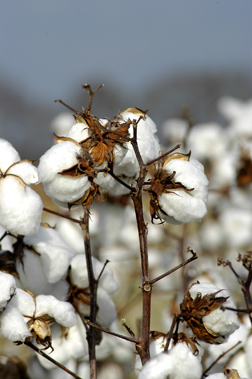Report Projects Big Cotton Gains For State In 2010

Cotton, once king of Alabama row crops, has not only slowed its rapid descent, but is expected to see the largest acreage increase of all state crops this year, according to the USDA’s 2010 Spring Planting Intentions report.Issued by the Alabama office of the National Agricultural Statistics Service, the agricultural survey of 1,024 state farmers projects a whopping 41 percent increase in cotton acreage — up from 255,000 acres to 360,000 acres. That’s more than 2.5 times the projected national increase of 15 percent to 10.5 million acres — up from 9.1 million — also the largest acreage increase of all crops.”Even though the 41 percent increase in cotton planting intentions over last year seems high, this is not so surprising considering historic cotton levels and the current strong market price,” said Bill Weaver, director of the Alabama field office for NASS. “This, along with the modest corn prices, makes planting cotton a viable option for many farmers.”But Buddy Adamson, director of the Alabama Farmers Federation’s Cotton Division, and Neal Isbell, a Colbert County cotton producer, say the outlook seems far too generous for cotton.
Adamson said an informal poll of farmers on the state cotton committee taken around the same time as the NASS survey reflected a much more moderate gain of only 15 to 18 percent. “Forty-one percent … that’s hard for me to see,” said Adamson.”It’s hard for me to see, too,” said Isbell. “I think, in surveying, they may have talked with some folks who were going to make a big increase and just didn’t hit some others…there are still a lot of people who haven’t had cotton for a few years and any increase is a big increase. You’ve got several producers across the Tennessee Valley who haven’t had any cotton who’ll have some cotton this year.”While many producers rotate their corn and cotton acreage, the report does reflect an optimism not shown by the state’s cotton farmers in 2009 when much of their crop was destroyed and fields flooded during last fall’s rains. In many cases, farmers were forced to delay harvest by several weeks — some as late as February. The arrival of warmer temperatures in mid-March helped ease the minds of those fearful of a nightmarish repeat.
News of the increased acreage is almost certain to be welcomed by financially strapped gins that had felt the brunt of cotton’s decline.But Isbell says he doesn’t expect 2010 to be a turn-around season for north Alabama cotton gins. “Any increase is going to be good news, but the Tennessee Valley is way overpowered with ginning up here. Several gins have shut down, and you are probably going to see a few more go by the wayside, but we’re still overpowered right now for the acreage we have,” Isbell said. “Most of the gin operators right now are just trying to survive or get through this bad time to where we can get to some better times. Basically, that’s where we are now. It’s going to take a bigger increase (in acreage) to really make the gins profitable. I hate to say it, but it’s going to take some more gins going out before it starts to catch up and correct itself. It always does. Supply and demand still works.”The only other state crops projected to see increased acreage are peanuts and sweet potatoes. Peanuts, which had experienced a 40,000-acre decline from 2008 to 2009 amid a salmonella scare at an Albany, Ga., processing plant, could rebound and see a 10 percent increase to 170,000 acres. Sweet potatoes, considered more of a specialty crop in the state, could see a 15 percent increase to 3,000 acres. Nationally, peanut acreage is anticipated to increase 8 percent to 1.2 million acres with sweet potatoes up 7 percent to 1.1 million.Other Alabama row crops are projected to decrease as more land goes into cotton. Soybeans and corn — both favorites in recent years — are expected to see declines of 20 percent and 11 percent, respectively. Soybean producers are expected to plant only about 350,000 acres, compared to 440,000 last year. Corn acreage could fall 30,000 acres to 250,000. Nationally, those crops are forecasted to see only moderate gains as corn acreage increases 3 percent to 88.7 million acres and soybean acreage rises 1 percent to 78 million acres.Winter wheat acres in Alabama decreased 5 percent from last year at 210,000, while oat acres are down 30 percent from 2009 at 35,000 acres. The estimated hay harvested acres is forecasted at 800,000, unchanged from last season.In June, the Alabama NASS office will conduct another survey to determine the actual acreage planted for each crop.
